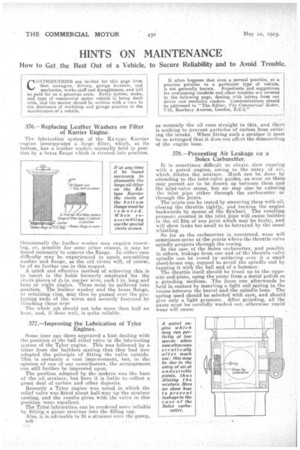HINTS ON MAINTENANCE
Page 32

If you've noticed an error in this article please click here to report it so we can fix it.
How to Get. the Best Out of a Vehicle, to Secure Reliability and to Avoid Trouble.
376.— Replacing Leather Washers on Filter of Karrier Engine.
The lubrication system of the K4-type Karrier engine incorporates a large •filter, which, at its bottom, ,has a leather washer. normally held ip position by a brass flange which is riveted into position.
Occasionally the leather washer may require renew'ing, or, possibly for some other reason, it may be found necessary to remove the flange. In either case difficulty may he experienced in again assembling washer and flange, as the old rivets will, of course, be of no further use in this respect. A quick and effective method of achieving this is to insert in the holes formerly employed for the rivets pieces of *-in. copper wire, each Lin. long and bent at right angles. Those must be soldered into position. The leather washer and the brass flange, or retaining ring, may then be pasSed over the projecting ends of the wires and securely fastened by clinching these over
The whole job should not take more than half an hour, and, if done well, is quite reliable.
377.—Improving the Lubrication of Tylor Engines.
Some time ago there appeared a hint dealing with the position of the ball relief valve in the lubricating system of the Tyler engine. This was followed by a letter from the builders stating that they had now adopted the principle of fitting the valve outside. This is certainly a vast improvement, but in the opinion of one of our contributors, the arrangement can still further be improved upon.
The position adopted by the makers was the base of the oil strainer, but here it is liable to collect a great deal of carbon and other deposits.
Recently a Tylor engine was noted in. which the relief valve was fitted about half-way up the strainer casting, and the results given with the valve in this position were excellent.
The Tylor lubrication can be rendered more reliable by fitting .a gauze strainer into the filling cap.
Also, it is advisable to fit a strainer over the pump, B46
as normally the oil runs straight to this, and there is nothing to prevent particles of carbon from entering the intake. When fitting such a strainer it must be so arranged that it does not affect the dismantling of the engine base.
378.—Preventing Air Leakage en a Solex Carburetter.
It is sometimes difficult to obtain .slow running with a petrol engine, owing to the entry Of air, which dilutes the mixture. Much can be done by attending to the inlet-valve guides, as :wear on these may permit air to be drawn up between them and the inlet-valve stems, but air may also be entering the inlet pipe either through the !carburetter or through the joints. The joints can be tested by smearing them with oil, closing the throttle tightly, and turning the engine backwards by means of the flywheel. The resulting pressure created in the inlet pipe will cause bubbles in the oil film of any joint which may be faulty, and will show leaks too small to be betrayed by the usual whistling. So far as the carburetter is concerned, wear will sometimes occur at the points where the throttle valve spindle projects through the casing.
In the ease of the Solex carburetter, and possibly in others, leakage from one end of the throttle valve spindle can be cured by soldering over it a small sheet-brass cap, cupped to avoid the spindle end by tapping it with the ball end of a hammer. The throttle itself should be trued up to the opposite end-plate, using the paste from a metal polish as a grinding medium. The faces can afterwards be held in contact by inserting a light coil spring in the recess between the barrel and the spindle boss. The spring used should be selected with care, and should give only a light pressure. After grinding, all the paste must be carefully washed out, otherwise rapid wear will ensue.


































